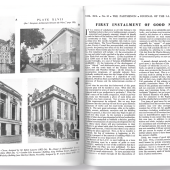A different take on fire

Part B’s head of specialist training, Steve Willett, explains why fire safety code BS9999 – and his CABE webinar on the subject – could offer useful benefits for members.
 When it comes to fire safety, Steve Willett isn’t short on professional experience. After leaving school and joining the Royal Navy where he served as a member of ships’ fire crews, Steve spent 13 years in the Fire Service, then a further 13 years in the fire safety department as an enforcing officer. Since retiring, he has been a fire consultant and a fire safety tutor. Steve’s current role is head of specialist training at fire safety consultancy firm Part B. So when he says that CABE members could benefit from a better appreciation of BS9999 ‘Code of practice for fire safety in the design, management and use of buildings’, it’s worth taking note.
When it comes to fire safety, Steve Willett isn’t short on professional experience. After leaving school and joining the Royal Navy where he served as a member of ships’ fire crews, Steve spent 13 years in the Fire Service, then a further 13 years in the fire safety department as an enforcing officer. Since retiring, he has been a fire consultant and a fire safety tutor. Steve’s current role is head of specialist training at fire safety consultancy firm Part B. So when he says that CABE members could benefit from a better appreciation of BS9999 ‘Code of practice for fire safety in the design, management and use of buildings’, it’s worth taking note.
“BS9999 provides another way of looking at some of the fire safety requirements of specifically commercial buildings, such as offices, shops, theatres and cinemas,” Steve says.
“If you look at a commercial building like these, when you fit a sprinkler system, fire safety Approved Document B [ADB] provides a few important details regarding compartment size and things like that. But BS9999 recognises a sprinkler system suppresses the fire, and with that reduced fire growth rate, it gives people in the building more time to get out of the building. So by reducing the fire growth rate, you can start to look at extending the travel distance safely. That’s one of the main benefits of BS9999.
“The other main benefit is that, in ADB, it specifically says that you must discount a staircase in the event of a fire, even if a sprinkler system is installed in the building. But with BS9999, when you put a sprinkler system in you don’t have to discount that staircase anymore – all stairs become available in the event of a fire.”
Despite being released back in 2008 and featuring obvious benefits – including flexibility with design elements such as ceiling heights, and enhanced detection and warning systems that allow extended travel distances and reduced exit and stair widths (which ADB does not allow) – BS9999 isn’t perhaps as widely adopted as it could be.
“The BS9999 document is quite large on first viewing and might be a bit overwhelming, But to my mind, compared to the very first time I picked up ADB, I feel that BS9999 has a better flow to it. It starts you at a point where you assign a risk profile and everything flows from that risk profile,” Steve says.
“CABE members can use it as a design guide for means of escape; you don’t need to be a fire engineer to use it. It sits above the traditional approach of ADB but below the fire engineer approach. In the case of BS9999, fire engineers have done all the calculations that need to be done – some of them pretty complex – and then they’ve summarised the information in tables.
“It’s a bit like the old logarithm tables that we all did at school years ago. Somebody else has gone through and done all the hard work to produce all the numbers; we can just look up the numbers that we need and apply them.”
BS9999 also features appendices with dedicated almost standalone guidance for specific requirements – although its important to note that designers should use BS999 or ADB in their entirety and not try to ‘mix and match’ guidance from both in the same project.
“If you are looking at designing a theatre or a cinema, then Annex D covers considerations such as auditoriums, stage arrangements, things like that,” Steve says.
“Annexes B and C cover the fire safety requirements for any building with an atrium, other than a block of flats. Annex B gives you the technical detail of it, which you’ve got to read; then Annex C takes you through a series of decisions trees and comes out with a package of fire safety measures that you should apply to that building.”
Webinar: means of escape
To provide CABE members with an even clearer understanding of the means of escape provisions outlined in BS9999, Steve has delivered an exclusive webinar.
“With the webinar, I couldn’t fit everything from BS9999 into an hour, but what I’ve tried to do is introduce the tables and give an overview of what those tables are trying to achieve and how you can use them to either extend travel distance or reduce stair width or, in some cases, increase things if you have to.
“So the webinar is all about the means of escape aspect of BS9999. If a building is on fire, how do you alert people and how do you get people out? We cover areas such as exit widths of doors, travel distances, height of escape route and management of fire safety in the building. It’s all about getting people alerted, getting people moving and getting them out of the building.”
Watch Steve’s BS9999 webinar below.







